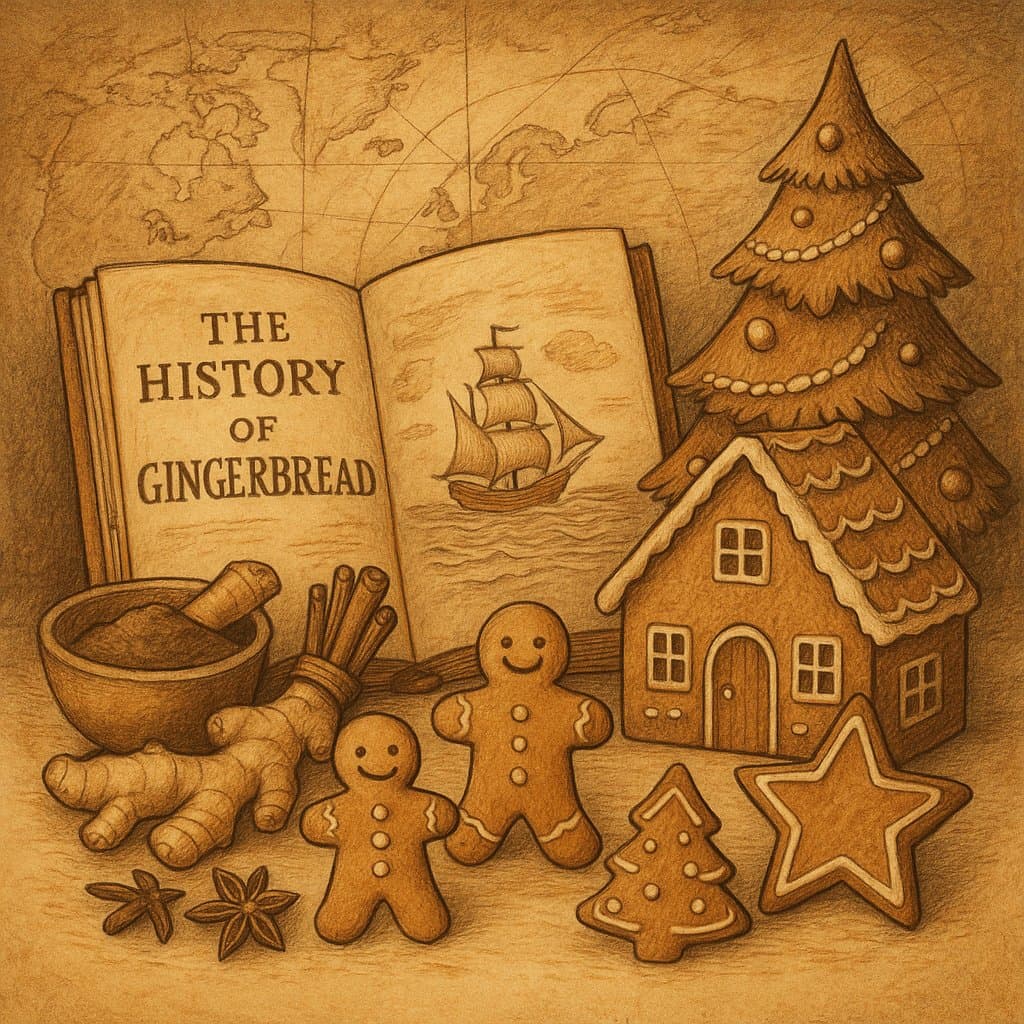The Story of Gingerbread: From Sacred Spice to Christmas Icon

The Story of Gingerbread: From Sacred Spice to Christmas Icon
Around the World in 80 Bakes: Stop #23 — Gingerbread
There’s something almost primal about the scent of gingerbread. It isn’t just sugar and spice — it’s a thread that reaches back a thousand years, to medieval marketplaces, royal kitchens, monasteries, and the global spice routes that once shaped empires.
To understand gingerbread is to trace how a luxury of the few became a symbol of festivity for the many.
Spice on the Silk Road
Ginger first reached Europe through the vast trade networks that linked Asia and the Middle East to the Mediterranean. It grew abundantly in China and South Asia, and by the first millennium, Arab traders carried dried ginger root across deserts and seas. By the 11th century, it had entered Europe through ports in Venice and Genoa, alongside cinnamon, pepper, and cloves.
This was not a spice for ordinary households. Ginger was rare, expensive, and prized for its warming properties. In medieval medical texts, it appeared as both food and medicine — believed to ease digestion and “warm the body’s humours” in cold weather.
Monks, Honey Cakes, and Early Recipes
The earliest European gingerbreads weren’t biscuits as we know them. In monasteries, bakers mixed breadcrumbs or ground almonds with honey, spices, and sometimes wine, pressing the paste into carved wooden moulds. These moulds often depicted saints, biblical scenes, or heraldic symbols, turning the sweet into both sustenance and sacred art.
One of the oldest written references to gingerbread in Europe appears in 13th-century records from France and Germany. Medieval gingerbread was dense, chewy, and sometimes aged for weeks to deepen its flavour — more like a spice cake than a crisp biscuit.
Gingerbread Guilds and the Baker’s Craft
By the 14th century, gingerbread had grown so popular in Central Europe that it became a protected craft. Specialised gingerbread bakers formed guilds in cities such as Nuremberg, Ulm, and Prague. Only guild members were allowed to bake gingerbread outside of religious holidays; the privilege of baking it year-round was a mark of status.
Nuremberg, rich in spices thanks to trade routes and famed for its craftsmanship, became the gingerbread capital of Europe. Its Lebkuchen — a soft, honey-rich spiced cake — was often baked without flour, relying on nuts and honey, then baked on thin wafers. It was luxurious, perfumed, and long-lasting, ideal for winter celebrations.
Gingerbread at Court
Gingerbread wasn’t just a guild commodity. It also appeared at royal banquets, where it was often shaped into the likenesses of kings and queens, glazed with gold leaf, and served as both decoration and delicacy.
In Tudor England, gingerbread took on another form: a dense, spiced cake tinted with saffron or coloured with sandalwood. According to legend, Elizabeth I of England had gingerbread figures made in the likeness of visiting dignitaries — a political gesture wrapped in sugar and spice. This helped popularise “gingerbread men” among the nobility.
The Fairground Sweetheart
As sugar became more accessible in the 16th and 17th centuries, gingerbread shifted from royal tables to public fairs. Gingerbread hearts, flowers, and animals were decorated with white icing and sold as tokens of affection. In some places, they bore mottos or sweet messages. To give someone a gingerbread heart was a declaration — romantic, playful, or cheeky, depending on the inscription.
Gingerbread fairs became common across Germany, Poland, France, and England, especially during festive seasons. In these bustling marketplaces, gingerbread became more than a delicacy; it became part of courtship, festivity, and folk custom.
Christmas and the Rise of the Gingerbread House
Gingerbread’s tie to Christmas crystallised in the 17th and 18th centuries. Its warm spices made it perfect for winter, and its long shelf life meant it could be baked and stored through the cold months.
Then came a fairy tale. The story of Hansel and Gretel by Wilhelm Grimm and Jacob Grimm (published in 1812) told of a house made entirely of sweets and gingerbread. German bakers, inspired by this image, began building decorative gingerbread houses during the holiday season — a tradition that quickly spread across Europe and beyond.
Migration, Molasses, and New World Traditions
European settlers carried gingerbread to the Americas, where ingredients like molasses — cheaper than sugar — gave it a darker, richer flavour. It adapted to new climates, ingredients, and tastes, becoming both a festival treat and an everyday cake in some households.
Recipes evolved to suit new kitchens and cultures, but the essence remained: spice, sweetness, and celebration.
A Heritage of Warmth
Gingerbread today wears many faces — crisp biscuits shaped into stars and men, towering houses held together with icing, soft cakes perfumed with ginger and cloves. But at its core, it’s a living heirloom. A sweet born of trade winds, monasteries, guild halls, royal banquets, and fairgrounds.
Each bake carries echoes of the world that shaped it — a winter tradition layered with history, memory, and warmth.
Curious to taste the history? Try our traditional gingerbread recipe here.
Share your thoughts
Did you find this history article interesting? Rate it below and let others know!